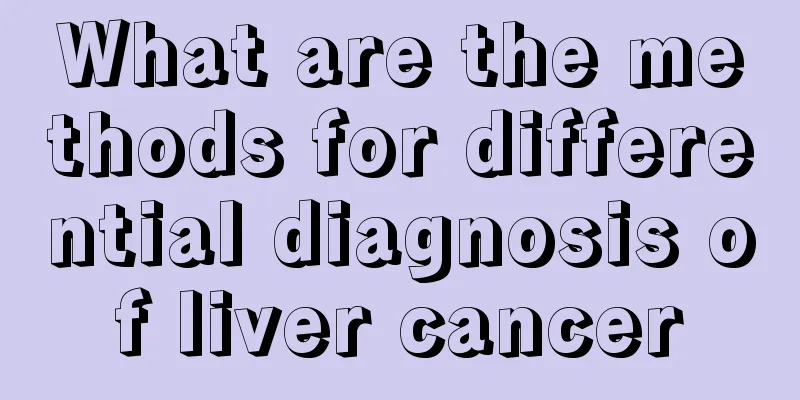What are the methods for differential diagnosis of liver cancer

|
In recent years, liver cancer has become one of the major diseases that endangers society and human health, and it has brought great pain and distress to humans. In order to reduce the incidence of liver cancer, we humans should master the differential diagnosis methods of liver cancer: 1. Secondary liver cancer: Compared with primary liver cancer, secondary liver cancer develops slowly and has milder symptoms. The most common type of secondary liver cancer is gastric cancer, followed by lung, colon, pancreas, breast, etc. Cancer foci often metastasize to the liver. It often presents as multiple nodular lesions. Alpha-fetoprotein (AFP) tests are generally negative, except for a few cases where the primary cancer is in the digestive tract. 2. Liver cirrhosis: Liver cancer often occurs on the basis of liver cirrhosis, and it is often difficult to distinguish between the two. Differentiation depends on a detailed medical history, physical examination and laboratory tests. Liver cirrhosis develops slowly and has recurrences, with more significant liver damage. A positive serum alpha-fetoprotein (AFP) often indicates cancer. 3. Active liver disease: The following points can help differentiate liver cancer from active liver disease (acute or chronic hepatitis). AFP alpha-fetoprotein test and SGPT alanine aminotransferase test must be performed at the same time. 4. Liver abscess: Symptoms include fever, pain in the liver area, and symptoms of inflammation and infection. The white blood cell count is often elevated, there is obvious percussion pain and tenderness in the liver area, tension in the left upper abdominal muscles, and edema of the surrounding chest wall. 5. Hepatic cavernous hemangioma: This disease is a benign space-occupying lesion in the liver, which is often discovered accidentally during physical examination, such as B-mode ultrasound or radionuclide scanning. This disease is common in my country. Differential diagnosis mainly relies on alpha-fetoprotein determination, B-mode ultrasound and hepatic angiography. 6. Hepatic echinococcosis: The patient has progressive enlargement of the liver, which is hard and nodular in texture. In the late stage, most of the liver is destroyed, and the clinical manifestations are very similar to primary liver cancer. The above is the differential diagnosis method of liver cancer. I hope patients will pay attention to it. Expert Tips: If you have symptoms of disease, do not delay diagnosis. You should go to a regular hospital for treatment in time to avoid delaying the disease and causing serious consequences. If you have other questions, please consult our online experts or call for consultation. Liver cancer http://www..com.cn/zhongliu/ga/ |
<<: What is the cause of lung cancer
>>: What dietary precautions should be taken for cervical cancer?
Recommend
Can I get pregnant while suffering from laryngeal cancer
Can you get pregnant during laryngeal cancer? Lar...
Dietary taboos for patients with small cell lung cancer
What are the dietary taboos for patients with sma...
Symptoms after being bitten by rove beetles
The rove beetle is a very poisonous creature. Its...
How to treat intrahepatic hemangioma? Treatment of intrahepatic hemangioma
Intrahepatic hemangioma is very common and genera...
What Chinese medicine should I take for rectal cancer
Blood in the stool is a typical symptom of rectal...
Is lung cancer pathological section harmful?
At present, lung cancer pathological biopsy is re...
The dangers of swimming for allergic rhinitis
Allergic rhinitis is a more serious and troubleso...
Is dilute sulfuric acid an electrolyte?
Dilute sulfuric acid is an aqueous solution of su...
What toothbrush should a one and a half year old baby use
Mothers who have taken care of children know that...
Will altitude sickness cause nosebleeds?
We all know that the higher the altitude, the thi...
Can inflammation in the lungs of adults cause jaundice?
Jaundice is a very common disease among newborn b...
Is lung cancer contagious? Detailed explanation of whether lung cancer is contagious
Is lung cancer contagious? This is a question tha...
What should patients with esophageal cancer eat
Esophageal cancer is a malignant transformation o...
What are the dietary care methods for liver cancer? Several dietary care methods for liver cancer
There are many patients with liver cancer. Once t...
What are the symptoms of advanced lung cancer? If there are 3 symptoms of lung cancer, it means it is in the advanced stage
Many diseases often have no obvious symptoms in t...









